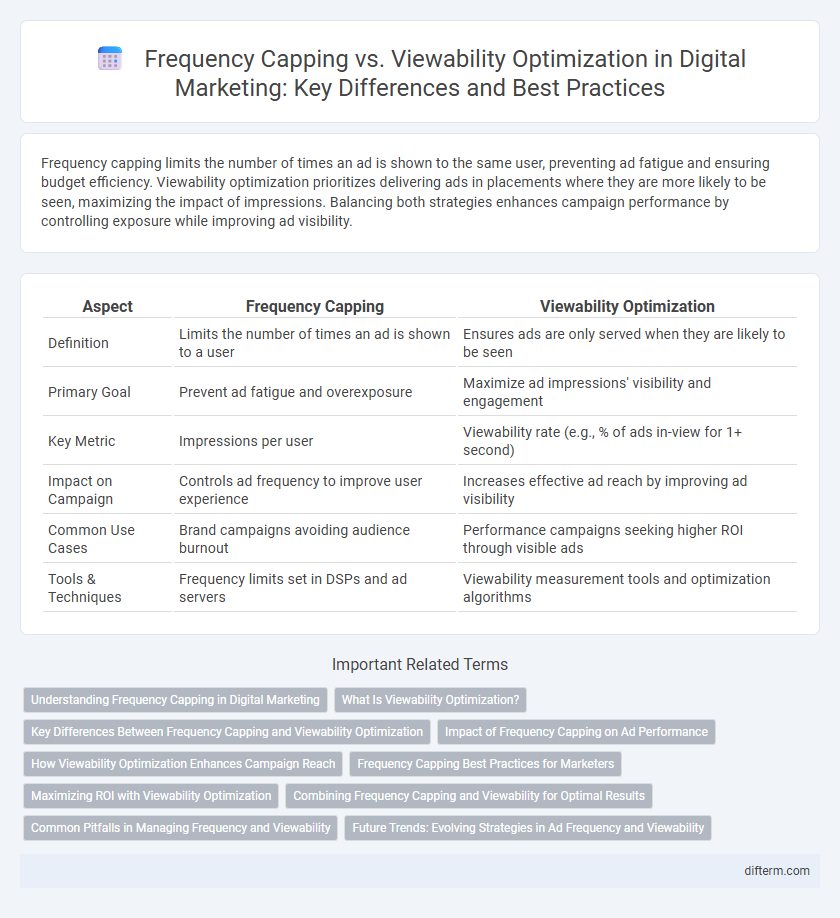Frequency capping limits the number of times an ad is shown to the same user, preventing ad fatigue and ensuring budget efficiency. Viewability optimization prioritizes delivering ads in placements where they are more likely to be seen, maximizing the impact of impressions. Balancing both strategies enhances campaign performance by controlling exposure while improving ad visibility.
Table of Comparison
| Aspect | Frequency Capping | Viewability Optimization |
|---|---|---|
| Definition | Limits the number of times an ad is shown to a user | Ensures ads are only served when they are likely to be seen |
| Primary Goal | Prevent ad fatigue and overexposure | Maximize ad impressions' visibility and engagement |
| Key Metric | Impressions per user | Viewability rate (e.g., % of ads in-view for 1+ second) |
| Impact on Campaign | Controls ad frequency to improve user experience | Increases effective ad reach by improving ad visibility |
| Common Use Cases | Brand campaigns avoiding audience burnout | Performance campaigns seeking higher ROI through visible ads |
| Tools & Techniques | Frequency limits set in DSPs and ad servers | Viewability measurement tools and optimization algorithms |
Understanding Frequency Capping in Digital Marketing
Frequency capping in digital marketing limits the number of times an individual user sees a specific advertisement, preventing ad fatigue and enhancing user experience. This strategy maximizes campaign efficiency by targeting impressions more effectively and reducing wasted ad spend. Compared to viewability optimization, frequency capping ensures repetitive ad exposure does not lead to diminishing returns, balancing brand recall with audience engagement.
What Is Viewability Optimization?
Viewability optimization in marketing ensures that ads are displayed within the visible area of a user's screen, increasing the chances of engagement and conversions. This technique leverages real-time data and algorithms to place ads where they can be seen, rather than just served, improving overall campaign effectiveness. Unlike frequency capping, which limits ad exposure to control user fatigue, viewability optimization prioritizes the quality of impressions to maximize return on ad spend.
Key Differences Between Frequency Capping and Viewability Optimization
Frequency capping limits the number of times a specific ad is shown to an individual user to prevent ad fatigue, enhancing user experience and preserving campaign budget efficiency. Viewability optimization targets the placement and timing of ads to ensure they are seen by users, increasing the likelihood of engagement and conversion by focusing on measurable impressions. The key difference lies in frequency capping managing exposure quantity, while viewability optimization focuses on the quality and visibility of each ad impression.
Impact of Frequency Capping on Ad Performance
Frequency capping limits the number of times a user is exposed to the same ad, reducing ad fatigue and preventing diminished returns on ad spend. By controlling ad exposure, advertisers can maintain higher engagement rates and improve click-through rates, leading to better overall campaign performance. Proper frequency capping balances reach and repetition, optimizing user experience while maximizing conversion potential.
How Viewability Optimization Enhances Campaign Reach
Viewability optimization ensures ads are seen by actual users rather than just served impressions, increasing the effective reach of marketing campaigns. By targeting placements with higher viewability rates, advertisers maximize the chances of engagement and reduce wasted ad spend caused by unseen ads. This strategic focus improves overall campaign performance and drives better ROI compared to relying solely on frequency capping.
Frequency Capping Best Practices for Marketers
Frequency capping ensures ads are shown to the same user only a limited number of times, preventing ad fatigue and preserving brand reputation. Implementing optimal frequency thresholds based on audience behavior and campaign goals maximizes engagement while minimizing wasted impressions. Marketers should analyze performance data regularly to adjust caps dynamically, balancing reach and frequency for improved return on ad spend (ROAS).
Maximizing ROI with Viewability Optimization
Frequency capping limits the number of times an ad is shown to the same user, preventing ad fatigue but sometimes reducing overall exposure. Viewability optimization ensures ads are displayed in positions with higher visibility and engagement rates, directly increasing the chances of conversion. Maximizing ROI requires prioritizing viewability metrics to enhance ad effectiveness and deliver more meaningful impressions that drive better campaign performance.
Combining Frequency Capping and Viewability for Optimal Results
Combining frequency capping and viewability optimization enhances ad campaign efficiency by controlling how often ads reach individual users while ensuring ads are viewable to maximize engagement. Frequency capping prevents ad fatigue by limiting repetitions, whereas viewability metrics ensure ads appear in prominent, visible screen areas. Integrating both strategies improves return on ad spend (ROAS) and boosts brand awareness by targeting quality impressions without oversaturating the audience.
Common Pitfalls in Managing Frequency and Viewability
In marketing, common pitfalls in managing frequency capping include over-restricting ad impressions, which can limit campaign reach and reduce overall engagement. Failing to optimize for viewability often results in wasted ad spend on impressions that users never see, diminishing ROI. Balancing frequency capping with viewability optimization ensures ads reach the right audience repeatedly without causing ad fatigue or visibility issues.
Future Trends: Evolving Strategies in Ad Frequency and Viewability
Future trends in marketing emphasize advanced frequency capping algorithms integrated with AI to balance ad exposure without causing fatigue, ensuring optimal audience reach. Viewability optimization is evolving through real-time analytics and machine learning, enabling advertisers to maximize ad placement effectiveness by targeting high-engagement environments. These strategies are converging as marketers leverage cross-channel data to create adaptive campaigns that enhance brand visibility while maintaining user experience.
Frequency capping vs viewability optimization Infographic

 difterm.com
difterm.com